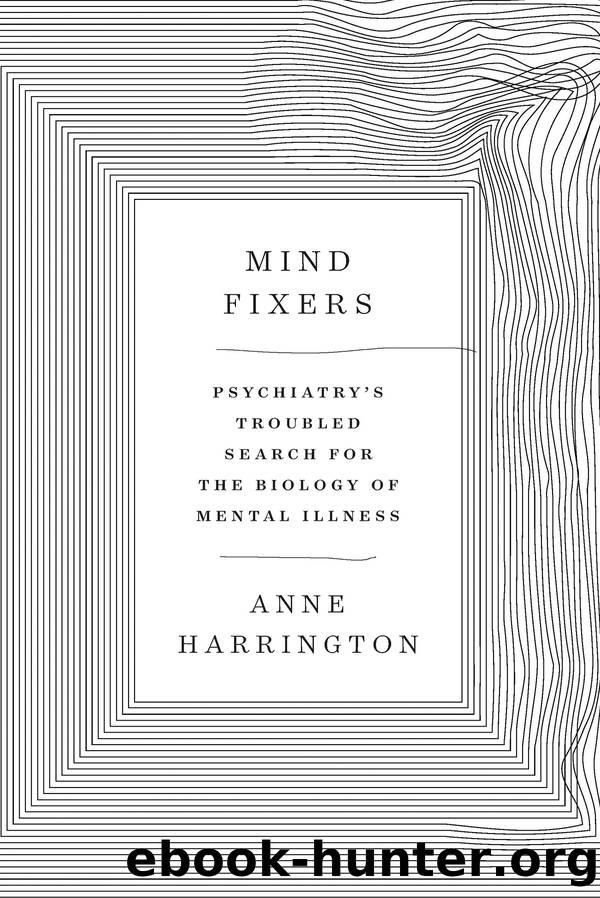Mind Fixers by Anne Harrington

Author:Anne Harrington
Language: eng
Format: epub
Publisher: W. W. Norton & Company
Published: 2019-02-21T00:00:00+00:00
This hypothesis, which has been designated the âcatecholamine hypothesis of affective disorders,â proposes that some, if not all, depressions are associated with an absolute or relative deficiency of catecholamines, particularly norepinephrine, at functionally important . . . receptor sites in the brain. Elation conversely may be associated with an excess of such amines.53
Schildkrautâs article would become the most frequently cited paper ever published in the American Journal of Psychiatry. Two years later he collaborated with Seymour Kety on another article, published in Science, that refined the original hypothesis, arguing strongly for seeing norepinephrineârather than serotoninâas the neurotransmitter that regulated mood states.54 The hypothesis linking low levels of catecholamine neurotransmitters (especially norepinephrine) to low moods would provide a theoretical focus to pharmacological research for the next quarter century.
Schildkraut always protested that he intended his âcatecholamine hypothesisâ to be no more than that: a hypothesis, a working theory, a tentative way of making sense of all the experimental literature to date. As discussion of the idea spread, though, it began to seem less like a hypothesis and more like a claim. And in the 1970s, the first discussions of depression as a âchemical imbalanceâ appeared in the popular literature. Publications from Cosmopolitan to the New York Times explained that depression was caused by deficits in essential brain chemicals, and that antidepressants could fix the problem.55 One 1977 newspaper headline from Stars and Stripes, written during the Thanksgiving season, summed up this new thinking in a particularly pithy way: âNo thanks on the holiday? Check your chemicals.â56
The new proposed linkages between disordered mood and disordered biochemistry even made it into courtrooms. On November 27, 1978, San Francisco was shocked to learn of the murders of a California public official named Harvey Milk and his colleague, Mayor George Moscone. Milkâs assassination in particular became a lightning rod for outrage because he was the first openly gay person elected to public office in the country. Both men had been murdered by a disgruntled former police officer, firefighter, and colleague of theirs named Dan White. White had resigned from the board on which all three men sat, partly because he had clashed politically with Milk on various initiatives. He had then changed his mind because he had not been able to get a different career financially off the ground, and so asked Moscone for his job back.
Originally Moscone was inclined to reappoint him, but Milk lobbied heavily for him to hold his ground, and so he had changed his mind. In apparent response to this outcome, White armed himself with a gun and climbed into a window of a government building to evade the metal detectors. He requested and was given permission to see Moscone. They argued over his reappointment, and then White shot Moscone in cold blood. From there, White went directly to Milkâs office and shot him five times as well, including twice in the head, execution style.
At Whiteâs trial, his lawyers suggested that he had not been wholly responsible for his actions because he was suffering from untreated depression.
Download
This site does not store any files on its server. We only index and link to content provided by other sites. Please contact the content providers to delete copyright contents if any and email us, we'll remove relevant links or contents immediately.
| Administration & Medicine Economics | Allied Health Professions |
| Basic Sciences | Dentistry |
| History | Medical Informatics |
| Medicine | Nursing |
| Pharmacology | Psychology |
| Research | Veterinary Medicine |
Periodization Training for Sports by Tudor Bompa(8102)
Why We Sleep: Unlocking the Power of Sleep and Dreams by Matthew Walker(6563)
Paper Towns by Green John(5029)
The Immortal Life of Henrietta Lacks by Rebecca Skloot(4453)
The Sports Rules Book by Human Kinetics(4221)
Dynamic Alignment Through Imagery by Eric Franklin(4055)
ACSM's Complete Guide to Fitness & Health by ACSM(3942)
Kaplan MCAT Organic Chemistry Review: Created for MCAT 2015 (Kaplan Test Prep) by Kaplan(3911)
Introduction to Kinesiology by Shirl J. Hoffman(3699)
Livewired by David Eagleman(3626)
The River of Consciousness by Oliver Sacks(3501)
The Death of the Heart by Elizabeth Bowen(3491)
Alchemy and Alchemists by C. J. S. Thompson(3426)
Bad Pharma by Ben Goldacre(3213)
Descartes' Error by Antonio Damasio(3193)
The Emperor of All Maladies: A Biography of Cancer by Siddhartha Mukherjee(3027)
The Gene: An Intimate History by Siddhartha Mukherjee(3014)
The Fate of Rome: Climate, Disease, and the End of an Empire (The Princeton History of the Ancient World) by Kyle Harper(2976)
Kaplan MCAT Behavioral Sciences Review: Created for MCAT 2015 (Kaplan Test Prep) by Kaplan(2909)
